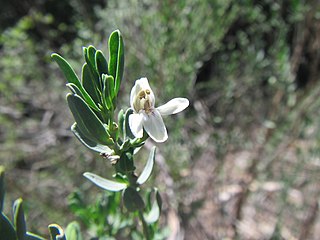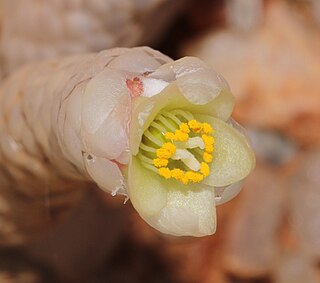
Citrullus ecirrhosus, commonly known as Namib tsamma, is a species of perennial desert vine in the gourd family, Cucurbitaceae, and a relative of the widely consumed watermelon. It can be found in both Namibia and the Cape Provinces of South Africa, in particular the Namib Desert. It is the sister species to the bitter melon, Citrullus amarus with which it shares hard, white and bitter flesh.

Moraea polystachya is a species of plant in the family Iridaceae native to southern Africa.

Pteronia paniculata is a species of flowering plant in the family Asteraceae, indigenous to the Karoo regions of South Africa.

Cyanella lutea is a species of cormous herb, native to South Africa and southern Namibia, where it grows in clay-rich or loamy soils.

Larryleachia perlata is a species of flowering plant the family Apocynaceae. The species is a succulent plant species. The species is considered an insufficiently known species.

Ornithoglossum undulatum, also known as the Karoo Slangkop, is a species of flowering plant in the family Colchicaceae. It is found in Southern Namibia and South Africa. In South Africa its range extends as far east as Somerset East in Eastern Cape Province. O. undulatum is a poisonous plant, and consumption of the leaves can kill livestock.

Chrysocoma ciliata is a shrub that grows to a height of 60 cm. The plant occurs throughout South Africa with the exception of Limpopo and also in Lesotho, Mozambique, and Namibia. In the Western Cape and the Eastern Cape it occurs along with the fynbos on rocky slopes and rocky plains.

Justicia cuneata is a species of subshrub in the genus Justicia. It is native to Namibia and the Cape Provinces of South Africa.

Roepera morgsana is a succulent plant species in the genus Roepera. It is endemic to Namibia and the Cape Provinces of South Africa.

Anacampseros papyracea is a species of succulent plant in the family Anacampserotaceae. It is endemic to Southern Africa.

Dimorphotheca acutifolia is a plant belonging to the genus Dimorphotheca. The species is native to the Eastern and Western Cape Provinces.

Arctotis arctotoides is a plant belonging to the genus Arctotis. The species is native to Lesotho, Namibia and South Africa.
Erica amoena is a plant that belongs to the genus Erica and forms part of the fynbos. The plant is endemic to the Western Cape and occurs, among other things, in the Table Mountain National Park. The plant is considered rare.

Watsonia tabularis, the Table Mountain watsonia is a plant that belongs to the genus Watsonia and forms part of the fynbos. The plant is endemic to the Western Cape.

Berzelia rubra is a shrub that belongs to the family Bruniaceae. The species is endemic to the Western Cape and is part of the fynbos. The plant occurs in the Kleinrivier Mountains and has an area of occurrence of less than 10 km2. The plant is threatened by the invasive plants such as Pinus and Hakea species.

Haemanthus deformis is a perennial flowering plant and geophyte belonging to the genus Haemanthus. The species is endemic to the Eastern Cape and KwaZulu-Natal and occur from Umtata to Durban. The plant only grows in the forests near the coast and is threatened by the traditional medicine industry.

Haemanthus humilis is a perennial flowering plant and geophyte belonging to the genus Haemanthus. The species is native to South Africa, it occurs in every province, as well as Botswana and Lesotho.

Haemanthus lanceifolius is a perennial flowering plant and geophyte belonging to the genus Haemanthus.

Haemanthus montanus is a perennial flowering plant and geophyte belonging to the genus Haemanthus. The species are native to Gauteng, KwaZulu-Natal, Mpumalanga, North West, Eastern Cape and the Free State as well as Botswana.

Haemanthus nortieri is a perennial flowering plant and geophyte belonging to the genus Haemanthus. The species are endemic to the Western Cape and occur on the Nardouwberg. The plant has an area of occurrence smaller than 100 km² and there are three subpopulations. It is threatened by overgrazing and trampling by livestock, road construction, invasive plants and illegal collection by horticulturists.


















